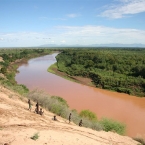UN Body Calls for Suspension of Gibe III Dam to Protect World Heritage
Places like the Grand Canyon, Taj Mahal and Great Wall of China are of such outstanding cultural or natural value that the world’s governments have committed to protect and preserve them for future generations. The UN’s World Heritage Committee recently called on the Ethiopian government and Chinese financiers to suspend the Gibe III hydropower project to fulfill their obligation for the protection of such a site. Read more about this exciting development.
Lake Turkana in Northern Kenya is the world’s largest desert lake. According to the World Heritage Committee, its unique ecosystem has made it “an outstanding laboratory for the study of plant and animal communities.” The area’s rich fossil finds have allowed reconstructing the history of animal species and mankind over the past 2 million years. Thanks to these unique properties, Lake Turkana was recognized and protected as a World Heritage Site in 1997.
Lake Turkana’s umbilical cord is the Omo River, on which it depends for close to 90 percent of its water inflow. The Gibe III Dam, which is currently under construction in Ethiopia, would disrupt this water supply. It would store almost a full year’s worth of the river’s flow, divert more water for the irrigation of sugar cane plantations, and completely alter the river’s natural cycle, on which the fragile ecosystems of the Lower Omo Valley and Lake Turkana have come to depend over thousands of years. A study commissioned by the African Development Bank found that the dam would likely cause a significant drop in the lake’s water level, increase its salinity, and threaten the unique ecosystem for which the lake was recognized as a World Heritage Site in the first place.
The Gibe III Dam is being built by an Italian company. ICBC, a Chinese state-owned bank, has approved funding for the project, and China’s export credit agency is financing the transmission lines. The dam would not only have devastating impacts on the Omo River and Lake Turkana, but also on the 500,000 indigenous people who depend on the river and lake for their livelihoods.
The threats posed to Lake Turkana spurred the World Heritage Centre, which coordinates international efforts regarding World Heritage Sites on a daily basis, into action. In March 2011, the Centre expressed concern about the construction of the Gibe III Dam in a letter to the Ethiopian government and requested additional information, including the project’s environmental impact assessment. The government claimed that it had taken precautionary measures to protect Lake Turkana, but did not provide any relevant documents to the Centre.
In June 2011 the World Heritage Committee, which oversees the protection of World Heritage Sites around the globe, convened for its annual meeting. The Committee took note of the threats and decided to take action for the protection of Lake Turkana and a host of other sites. It expressed “utmost concern” about the proposed construction of the Gibe III Dam and urged the Ethiopian government to “immediately halt all construction” on the project. It asked the governments of Kenya and Ethiopia to invite a monitoring mission to review the dam’s impacts on Lake Turkana, and encouraged financial institutions “to put on hold their financial support” until the Committee’s next annual meeting in June 2012. Interestingly, both China and Ethiopia are currently among the 21 members of the World Heritage Committee.
Lake Turkana is not the only World Heritage Site which is threatened by dam construction. In a report to the Committee, the World Heritage Centre and the World Conservation Union IUCN proposed that “all major dams affecting World Heritage properties (…) should undergo thorough environmental and social impact assessments in line with the international best practice principles, comply with the World Commission on Dams (WCD) guidelines regarding options assessment, public participation, environmental flows, compliance, and benefit sharing, and be submitted to the World Heritage Committee for review and consideration prior to granting of approval.”
China and Ethiopia both have important World Heritage Sites, including the Summer Palace, the Great Panda sanctuaries of Sichuan, and the Lower Awash Valley where the remains of the famous Lucy were found within their borders. When they signed the World Heritage Convention, the two countries accepted an international legal responsibility to protect such sites around the world. With the decision of the World Heritage Committee, the Gibe III Dam is no longer a matter of debate between dam builders, affected communities and environmental organizations. The governments of Ethiopia and China now have a duty to act.
Peter Bosshard is the policy director of International Rivers. He blogs at www.internationalrivers.org/en/blog/peter-bosshard and tweets @PeterBosshard.
This update is also available in Chinese here.






